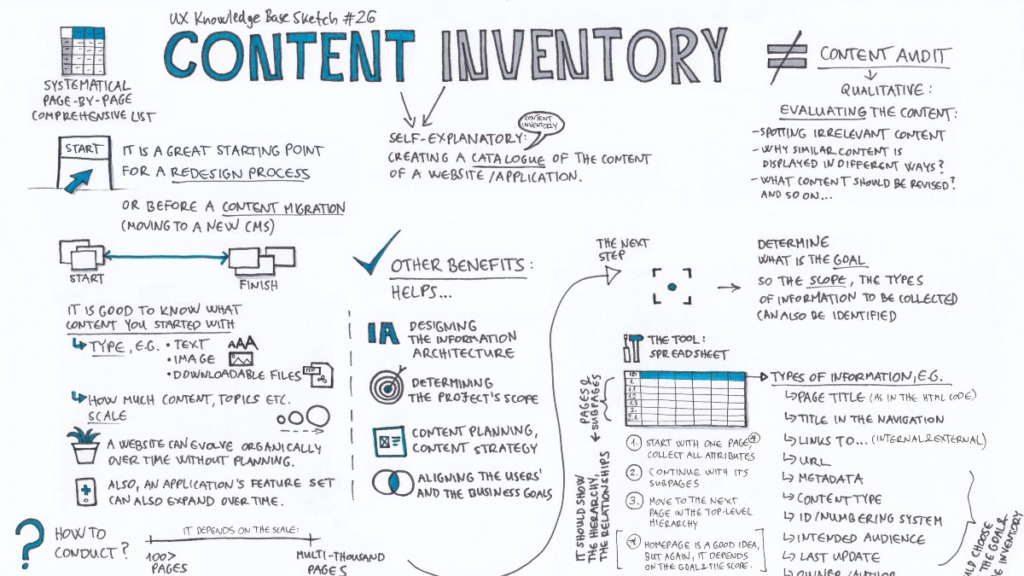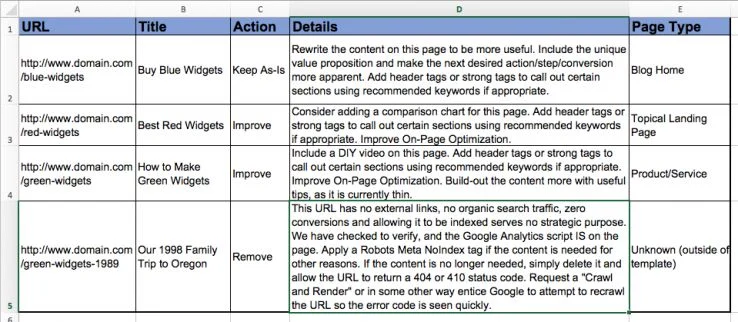A Detailed Guide to the Content Auditing Process

While creating a website and filling it with content, we often forget that a lot of content doesn’t mean quality content. Good content should be concise, useful, and provide value to the readers.
So, if you feel you’re lagging behind your industry competitors due to poorly performing content, you should initiate a content auditing process for your entire website. With a step-by-step content auditing process, you will be able to weed out the under-performing content spoiling your website’s credibility and search rankings.
In this article, we will talk about a content inventory, effective content auditing methods, and how to do a content audit process for your website.
What Is a Content Inventory?

When you intend to execute content auditing for your website, you will come across the term – content inventory. Since you might not want to create a content inventory on your own, several content auditing tools (CAT) will help you form a quantitative collection of all content on your website.
A content inventory is the complete quantitative information enabling your team to understand what type of content you create, how you’ll organize the content, and implement your content auditing process. The thorough procedure of cataloging all the content of your website in accessible format results in creating a content inventory.
This makes your content auditing job easier and helps you establish solid KPIs (key performance indicators).
Performing a content auditing process will be extremely simple if all your content is found in one place from where you could find out the ‘superstar’ content and the ‘underperforming’ ones.
Assessing the relative strengths and weaknesses of content becomes immensely easy if you have a quantitative collection of all the text, images, applications, documents, and every other piece of content in a single place. This single place is known as a content inventory, and it can be considered your first step to initiating the content auditing process of your website.
Like a catalog helps you organize stuff, a content inventory enables you to perform an extremely efficient content auditing process. Now that we know about the first step, let’s move to the most critical process we are concerned about.

What Is Content Auditing?
A content audit involves looking at and analyzing all the content on your website and assessing its relative strengths and weaknesses.
Content auditing executed most practically can help you weed out stale, obsolete, and irrelevant content. Furthermore, it enables you to gain insights into your website, your future content marketing strategies, and everything that will help your content outpace your peers.
In short, it is a qualitative assessment where you scrutinize the comparative strengths of your website content based on the pre-established KPIs (key performance indicators).
But why do you need content auditing? Why do you need to review the existing content of your website closely?

A well-executed content auditing plan ensures several upsides for your website and your business. A well-performed content audit does not only tell you what your website lacks or what your business should include in terms of content. It gives you a chance to closely review all the minute details of your current content strategy and formulate a newer, more polished one.
Therefore, content auditing might have its roots in refurbishing, polishing, and creating new content. However, its real strength lies in giving you a direction for your future content strategy. Formulating a content marketing strategy based on the content auditing results will help you create a more effective content plan and execute it successfully.
5 Steps to Carry Out an Efficient Content Audit
Content auditing needs to be comprehensive so that all your goals and objectives in terms of business and website performance are well-met through your content. Therefore, you should follow the following five steps to perform effective content auditing and help your website content flourish.
- Knowing the exact reason for performing the content auditing process.
- Use tools like Screaming Frog to index your URLs.
- Incorporating Google Analytics Data to monitor all the critical data and information regarding your website’s content and its performance.
- Analyzing and examining the findings from the Google Analytics Data to help you create an action plan–the content to eliminate, the ones to keep, the ones to refurbish or revitalize, how to change the content strategy to align with the target audience, etc.
- After you receive the Google Analytics Data, you need to create an action plan for content auditing and go forward with it.
These five steps will help you implement a comprehensive content auditing procedure for your website. Although, these days, several automated tools are available to perform content auditing and content gap analysis without you manually doing anything.
Benefits of the Content Audit Process

There are several resources available that make content auditing a cakewalk. However, before executing content auditing, you should understand the several benefits that it will endow your website with. In terms of content, a content auditing process enables you to:
- Pinpoint the most highly-performing content pieces from the past.
- Discovering pages that contain overlapping content.
- Identify pages with content creating high impressions but not adequate conversions.
- Align your content with your target audience’s preference.
- Eliminate similar and duplicate content.
- Identify multiple ways to improve organic search performance and naturally help the content rank high.
Even if we know how to do the content audit process, we have several questions hovering in our minds for which we need detailed answers. How can a well-executed content auditing plan help you understand your website’s current goals and establish the future ones better?
A well-implemented content auditing demonstrates a few simple facts that could have enormous implications for the success of your website or your business. These are:
Content worth keeping
Content auditing helps you understand which content on your website is good and worth keeping. It lets you figure out the evergreen content within your website that should not be changed as it continues to provide value to your readers.
You can also revitalize the older content to resonate with your readers and eliminate any irrelevant content that could hurt your already powerful content.
Improving your existing content and developing better content in the future
The next goal of content auditing is to help you understand what needs improvement in your website’s content development and execution—creating a flowchart to deal with your business’s content development goals in the future. A content auditing process will help you create just that.
Tossing away bad content that does more harm than good
We all have some content on our website that has no goal or a clear vision. Such content underperforms and destroys the credibility of our website’s existing content.
It also has a marked effect on the website’s visibility, ranking, and performance. A well-thought-out content auditing plan helps identify such no-good content and weed it out from the website.
Identifying content gaps in the sales funnel
Most of the content that we create aligns with the AIDA sales funnel. By this, first, we try to capture the attention of our target audience using the content. The next role of the content comes in inciting their interest in the product/services and creating the desire in them to acquire those products or services. The final part of the sales funnel content urges the customer to take action, purchasing the product/services.
However, often, we do not perform a content gap analysis in the existing content plan. Without a holistic content auditing process, it is difficult to find out the content gaps within the funnel and analyze them. And if such content gaps persist, the sales funnel will never be foolproof and ensure high conversion rates.
Creating a content strategy for the future
Your website needs to have high authority, bring in qualified leads, encourage sales, nurture those leads, and do everything to ensure a massive ROI for your business’s success. However, these objectives will only be possible if it has good reach, visibility, and rankings.
A well-thought-out content strategy is the only thing that will help your website pull off such enormous goals and thereby make your business a success. When you ensure a comprehensive content auditing process, it also helps lay the foundations of a successful content strategy in the future.
Key Takeaways
- Content inventory and content auditing are two very different processes.
- A content inventory is a collection of the quantitative data of all the content present on your website. Content auditing ensures measuring and analyzing the content present on your website using qualitative KPIs.
- Content auditing your website from time to time is crucial so that your customers’ content needs are aligned with those present in your website, and it boosts sales.
- Performing a content audit from time to time can help analyze the content gaps in your sales funnel, improve organic search ranking, eliminate irrelevant or bad content, improve the good ones, and revitalize your content strategy from time to time.
Conclusion
Content auditing is not just crucial for your website’s performance. It’s also important for your overall business’s performance, as all your website’s content is created to elevate your business objectives and help you earn better conversion rates.
Although content auditing might seem intimidating and overwhelming, it’s simply the kind of maintenance your business website needs from time to time. It ensures your website is in the best shape and enables the content to perform according to the pre-formed plan to ensure big successes.
FAQs
Content auditing is an important part of a content strategy. It helps evaluate your content marketing strategies by giving you the opportunity to organize all your content on record and to make clearer plans for future content.
Content auditing entails collecting and analyzing assets on your websites like blog posts or landing pages. Auditing ensures keeping an inventory of the website and providing insight into which content you should create, upload, remove, or re-work.
Ideally, you should audit your content every three to six months.
Latest Blogs
Explore how Google’s 2025 AI search updates triggered ranking chaos. Learn actionable strategies to adapt your SEO for AI Overviews, zero-click searches, and SERP volatility. Stay ahead now.
Learn how to rank on AI search engines like ChatGPT, Perplexity, and Gemini by optimizing your content for authority, structure, and relevance. Stay ahead in AI-driven search with this strategic guide.
Explore the best healthcare SEO services for your medical practice. Improve online visibility and effectively reach more patients in need of your services.
Get your hands on the latest news!
Similar Posts

B2C Marketing
5 mins read
Top Choices for Best Content Marketing Services in B2B Industries

Artificial Intelligence
5 mins read
How A Lead Generation Specialist Can Use AI-Powered Content Funnels to Drive Conversions

Artificial Intelligence
4 mins read